| Players can be classified according to the entries. |
|---|
| 1.Tanto (dagger) under 45cm |
 |
|
In this division, the men and the do are the areas mainly aimed at. Therefore, you need to pay special attention to protect these critically important areas. Strikes on thre men are valid hrer. A player cannot get a game-deciding point as long as he strikes the defending arm or the legs. Abdominal areas as well as the chest or the throat are important parts for earning points.
On judging matchesm, it is remembered that referees have some likelihood of misjudgment due to the circumstances where players place themselves close to one another, and move quickly. Referees have also to draw a line between the atedome and mikiri. They need, therefore to be trained to perceive subtle differences in techniques.
* Although it is mandatory, for safety, please wear glove in matches used in Jo, Bo, Tanto.
Gloves used for hitting people is prohibited. (Boxing, Karate, and so on.)
[Spochan gloves]

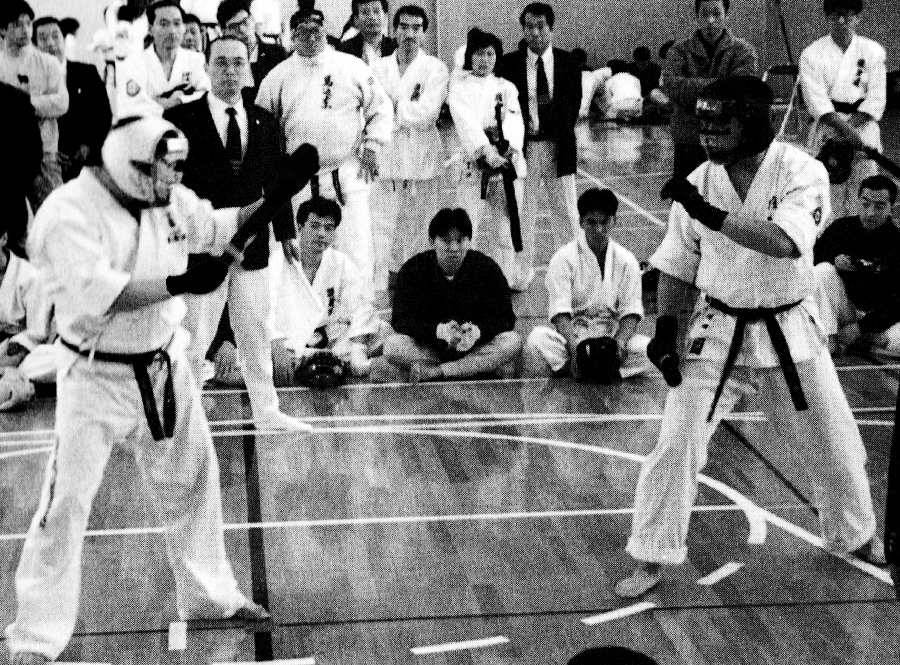
|
| 2.Kodachi (short sword) under 60cm |
 |
|
|
The kodashi is such a popular division of sports chan-bara that we even say "you start sports chanbara from the kodachi, and pursue the way only to find yourself with the kodachi in the end."
The kodachi is also the introduction to this sports.(As for the details of the use of the kodachi, refer to "Kodachi Goshindo" by Tetundo Tanabe, published by Sobunsha) For practice, you can substitute a kodachi with something like a magazine.
The kodachi is about the size of a wooden stick or trouncheon, which can be a practical, handy means of self-defense.
Sports chanbara is very casual to play as you can thus use a newspaper as a sword. You will enjoy playing only by learning some basic strikes like Ogi uchi, and kakoi-nuki for defense.
Although the sword itself is short, skilled player's handling of the kodachi is surprisingly quick that it sometimes surpasses a long sword. This is a sports suit-able to a sports festival.
 Practice match [Kodachi]
Practice match [Kodachi]

|
3.Choken (long sword) under 100cm

There are multiple categories.
-
Choken-Free (free style) with one hand
This is a free handed style like rapiers and sabers in Europe.
-
Choken-Ryote with both hands
Please remember Japanese Kendo style.
|
|
The choken was at first played either with a single hand or with two hands.
As Players furthered their experience in competitions, however, many of them turned out to adopt the single-hand handling.
In other words, the two-hand handling, exemplified by kendo, have given way to the single-hand handling. Also, in the one-hand handling, a saber's sweeping cut is seen as more advantageous than a rapier's stabbing. Ashibarai (sweeping on the leg) is a particularly effective action, which often helps decide a match. The two-hand handling is posture peculiar in Japan, while the single-hand handling prevails profoundly over many other places of the world.
 Practice match
[Choken-free vs. Choken-ryote]
Practice match
[Choken-free vs. Choken-ryote]
 [Choken-ryote]
[Choken-ryote]
|
4.Nito


You can defend and attack at the same time.
It is good to use short weapons for defense, long weapons for attacks.
You can choose a free combination.
-
Nito with Kodachi and Choken, under 160cm (In tournament, this style is mainly)
-
Nito with two Kodachi, under 120cm (for a small child)
-
Nito with two Choken, under 200cm (original style)
|
|
|
This style has been regarded as a particularly peculiar style, and Miyamoto Musashi in very famous SAMURAI in Japan as a swordsman of this style. However, this style is particularly familiar around Europe and we can see solders with two-hand swords (nito) in some countries of Europe. You can put your sword forward in your left front or right front/ Kodachi is also effective in self-defense as well as in striking.
 Practice match [Nito]
Practice match [Nito]
|
5.Tate under 45cm (shield and sword)

There are multiple categories.
-
Tate-Kodachi (Tate and Kodachi), under 100cm
-
Tate-Choken (Tate and Choken), under 140cm
-
Tate-Tanto (Tate and Tanto), under 90cm
|
|
In Japan, people have rarely used 'tate' or shield in fighting; it is because they have learned to handle a sword with two-hand since Momoyama period. On the other hand, the shield is highly developed as part of swordsmanship in areas like Europe or Africa. Since they can handle both of equipments by keeping balance and timing, it is very rational means for fighting because it enables attacking as well as protecting yourself.
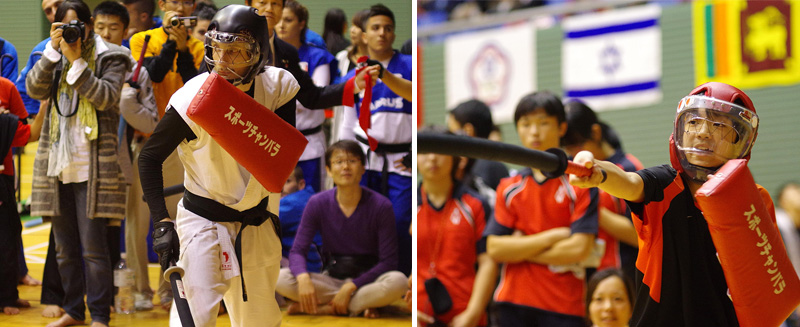
|
6.Jo (short stick) under 140cm
 |
|
|
There are two kinds of Jo. One is a short version of bo and the other is the choken with a long grip. In addition, other various swords like three piece rod, chigirigi, nunchaku, kusarigama and Tonfa are all included in this division.
* Although it is mandatory, for safety, please wear glove in matches used in Jo, Bo, Tanto.
Gloves used for hitting people is prohibited. (Boxing, Karate, and so on.)
[Spochan gloves]

|
7.Bo (long stick) under 200cm
 |
|
|
Once accustomed, a player can exert a variety of exciting techniques with a bo.
It shows its strength in fighting against the choken or the nito-ryu.
It does not, however, work well against something like the yari.
It sometimes displays unexpected movements such as sayuu-chi, which uses both ends of a bo one after the other, kaiten (spin and strike), yokomen-uchi, or ashiuchi.
* Although it is mandatory, for safety, please wear glove in matches used in Jo, Bo, Tanto.
Gloves used for hitting people is prohibited. (Boxing, Karate, and so on.)
[Spochan gloves]

Bo
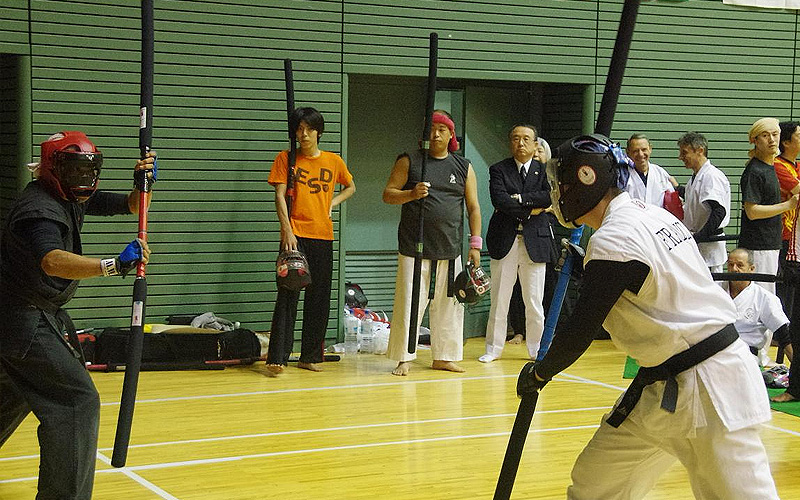
|
8.Yari under 200cm

There are multiple categories.
-
Tanso (It uses Choken. thrusting), under 100cm
-
Choso (It uses Yari. thrusting), under 200cm
-
Nagamaki (It uses Yari. sweeping), under 200cm
|
|
|
It is really meaningful to master the yari as sports.
With the exception of guns, no other swords have achieved such an exclusive performance as the yari.
It is characterrized by its simple and direct power and contributed to battles to a great extent in old times.
Nowadays, you can still find 'kakeyari' in japanese traditional houses with 'nageshi', which explains SAMURAI's prosperous days in their past.
If swordsmanship is three times as advantageous as unarmed combat, handling yari could then be three times as advantageous as swordsmanship. Despite its excellencies, the art of yari only remains in some old martial arts now, and otherwise are not able to attract people's attention nowadays.
It is partly because yari has not developed as one of sports and we are to be blamed for this situation.
In Olympic Games, yari as one of modern sports can be found in javelin, however, handling yari with two-hand on the basis of historical parts.
As we master Sports Chanbara, it is inevitable that we understand yari with linear and unwanted motion.
'Nagamaki', 'Naginata', 'Oomiyari' and other types of spear, there are not so much technical difference in the way of handling.
The named of each naginata is different on the basis of the way it is used in ting or sweeping on each occasion.
In actual fighting, every type of handling such as thrusting, sweeping, tripping, beating, and striking would be used.
Partisans in Europe, all of them are used.
Choso
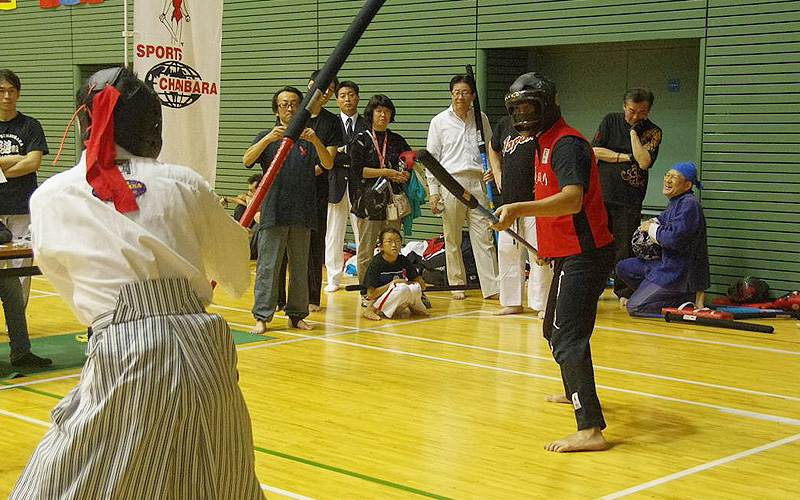
Nagamaki
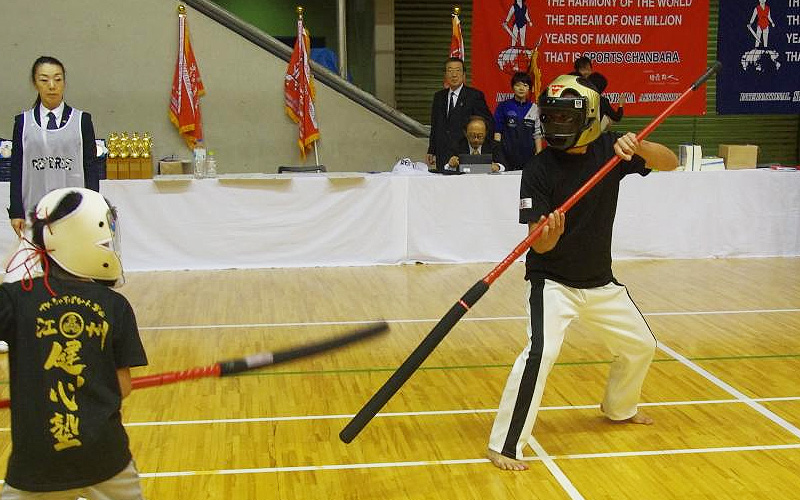
|
Sports Chanbara Playing is divided into these categories.
In a tournament, The champion from each category fights in the last match and the final champions is admired as the only World Champion that year.
|
Other competition |
| Katsusen |
The Katsusen (team match) was a common way of fighting in old days, so it is rather unnatural that there has been no match of this way these days.
With the call of "hajime" for start, its practice is carried out by two groups (red and white team) consisting of more or less the same number of players.
Judging can be difficult in the katsusen as many players are on the contest area at the same time. Therefore, a self-assessment system is adopted. Players are to recognize their own defeats when they have had any effective strokes.In this case,they either fall down on the floor or retreat. As a matter of fact, matches can be melees, involing atouchi (delayed blows), mikatauchi (attacks from companies), and 2 or one or 3 on one (simultaneous attacks from some opponents), and so on.
The katsusen is divided into two kinds of matches. One is called gentei-sen (limited-sword match), where the kind of the equipment that can be used is set in a certain range, such as a match where only the kodachi is used. The other is called weapon jiyu-sen (free-equipment match). In a free match with long swords of over two meters, it is better to coincide the number of players between the two teams.The most essential thing here is the self-assessment. Only when the players acknowledge their defeats does the match work.If there are any players who fall short of this self-assessment or respectable behavior, the match cannot bo carried out. SportsChanbara, in this context, has an element of helping a player form established personality. It aims to encourage him to be the one who does not stick to victory or defeat, and is not hesitant to recognize his defeat and willing to congratulate his opponent.
|
|
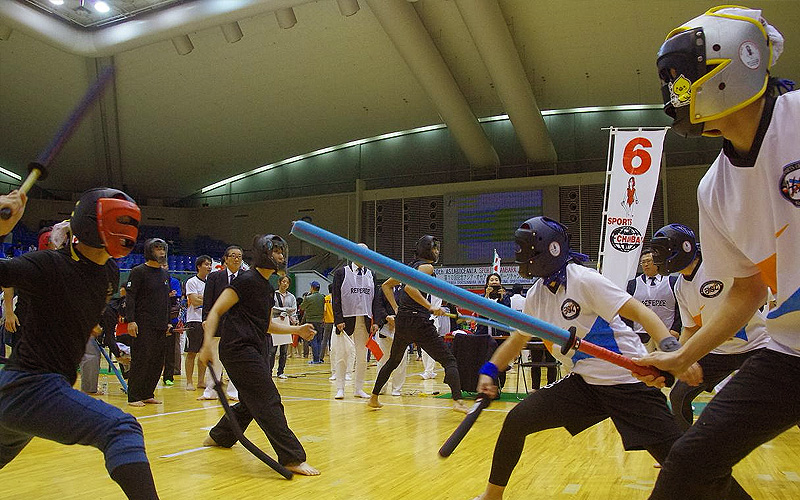
|
| Ransen |
Tanin-Gake
Tanin-Gake is a way of fighting that puts a group of contestants against another group that comprises a different number of comtestants, such as a few contestants against one, or three to five against two. It is seen in the fighting where the two team that are the same in number play. It fosters various aspects of human relations that cannot be acquired through one-on-one, individual matches. Players will learn things like taking care of others, co-operation, solidarity, union for protection, recognition of one's standpoint, role, responsibility and fellowship within a group.
That comes from the fundamental of the art of self-defense, which plays virtually important roles for the cultivation of aesthetic sensitivity, such as fostering the sense of taking care of others like friends and family members.
In the field of the Ransen or Katstsen, some potentials that help people develop new relations, which is not seen in individual matches, are sometime recognized. How an individual plays his role in a group is a very important issue.In this respect, this kind of fighting means a lot as it enables players to experience, through fighting, the way to survive, to behave, and to understand the activity and psychology of a group.
|
|